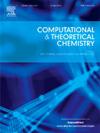2 -巯基苯并咪唑衍生物功能化石墨烯:金属阳离子在水中吸附的结构和键合分析
IF 3
3区 化学
Q3 CHEMISTRY, PHYSICAL
引用次数: 0
摘要
本研究对烷基取代的2-巯基苯并咪唑衍生物修饰石墨烯作为水中金属阳离子的定制吸附平台进行了全面的计算研究。DFT计算、MEP和QTAIM分析表明,原始石墨烯对电荷转移驱动的各种金属离子具有中等的吸附能。用MBI衍生物修饰石墨烯的吸附能在15到21 kcal/mol之间,在某些情况下,显著增强了金属结合。值得注意的是,MBIM-Cu2+配合物的吸附能显著增加,而G-MBIE-Pb2+体系通过与石墨烯和改性剂的协同作用,稳定性得到了提高。详细的化学键分析表明,这些相互作用是由静电力、电荷转移和共价键的结合产生的。这些发现强调了化学修饰石墨烯作为重金属选择性吸附剂的潜力,为下一代水修复材料的设计提供了有价值的见解,并推进了对金属-石墨烯相互作用的分子水平理解。本文章由计算机程序翻译,如有差异,请以英文原文为准。

Graphene functionalized with 2–mercaptobenzimidazole derivatives: Structural and bonding analysis on metal cation adsorption in water
This study presents a comprehensive computational investigation into graphene modified with alkyl-substituted 2-mercaptobenzimidazole derivatives as tailored adsorption platforms for metal cations in water. DFT calculations, complemented by MEP and QTAIM analysis, reveal that pristine graphene exhibits moderate adsorption energies for various metal ions driven by charge transfer. Graphene modification with MBI derivatives had adsorption energies ranging from 15 to 21 kcal/mol and, in select cases, significantly enhances metal binding. Notably, the MBIM-Cu2+ complex displays a marked increase in adsorption energy while the G-MBIE-Pb2+ system demonstrates improved stability via synergistic interactions with graphene and the modifier. Detailed bonding analyses show that these interactions arise from a combination of electrostatic forces, charge transfer, and covalent bonding. These findings underscore the potential of chemically modified graphene as a selective adsorbent for heavy metals, offering valuable insights for the design of next-generation water remediation materials and advancing the molecular-level understanding of metal–graphene interactions.
求助全文
通过发布文献求助,成功后即可免费获取论文全文。
去求助
来源期刊

Computational and Theoretical Chemistry
CHEMISTRY, PHYSICAL-
CiteScore
4.20
自引率
10.70%
发文量
331
审稿时长
31 days
期刊介绍:
Computational and Theoretical Chemistry publishes high quality, original reports of significance in computational and theoretical chemistry including those that deal with problems of structure, properties, energetics, weak interactions, reaction mechanisms, catalysis, and reaction rates involving atoms, molecules, clusters, surfaces, and bulk matter.
 求助内容:
求助内容: 应助结果提醒方式:
应助结果提醒方式:


